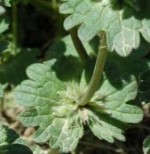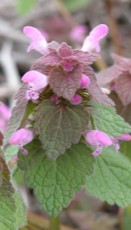 Henbit, also known as dead nettle, blink nettle, and bee nettle, is a winter annual or biennial native to Eurasia and Africa that has naturalized throughout the United States including Hawaii, but not Alaska. It is most common in the eastern states and is considered invasive in some areas. It prefers sun to part sun, moist to mesic loamy, fertile soil and can be found in lawns, gardens, waste areas, pastures, and fields. A cool weather plant, henbit may go dormant during the heat of summer. Flowers attract long tongued bees including honey bees and bumble bees.
Henbit, also known as dead nettle, blink nettle, and bee nettle, is a winter annual or biennial native to Eurasia and Africa that has naturalized throughout the United States including Hawaii, but not Alaska. It is most common in the eastern states and is considered invasive in some areas. It prefers sun to part sun, moist to mesic loamy, fertile soil and can be found in lawns, gardens, waste areas, pastures, and fields. A cool weather plant, henbit may go dormant during the heat of summer. Flowers attract long tongued bees including honey bees and bumble bees.
 Description: Plants appear in the garden in the fall after the soil has been disturbed by the removal of annuals and general fall clean up. They overwinter as a few leaves but begin to grow in late winter-early spring. Leaves are round in outline, about 1” across, and have scalloped edges.
Description: Plants appear in the garden in the fall after the soil has been disturbed by the removal of annuals and general fall clean up. They overwinter as a few leaves but begin to grow in late winter-early spring. Leaves are round in outline, about 1” across, and have scalloped edges.  The lower ones have long petioles but the upper ones wrap around the stem in a unique way, giving rise to the specific name, amplexicaule. The lower leaves are opposite, hairy, and palmately veined. Stems are square in cross section, hairy, and green or reddish brown, sometimes tinged with
The lower ones have long petioles but the upper ones wrap around the stem in a unique way, giving rise to the specific name, amplexicaule. The lower leaves are opposite, hairy, and palmately veined. Stems are square in cross section, hairy, and green or reddish brown, sometimes tinged with  purple. They lie on the ground with ascending tips and can root where the nodes touch the soil. Pink to purple flowers appear in mid-spring in small clusters above the upper leaves starting in mid-spring and continuing one to two months. The flowers consist of fused petals with an upper and lower lip, the former with a frizzy beard. Each flower gives way to four small egg-shaped nutlets that are brown with white spots. The root system is a short taproot with many fibrous branches.
purple. They lie on the ground with ascending tips and can root where the nodes touch the soil. Pink to purple flowers appear in mid-spring in small clusters above the upper leaves starting in mid-spring and continuing one to two months. The flowers consist of fused petals with an upper and lower lip, the former with a frizzy beard. Each flower gives way to four small egg-shaped nutlets that are brown with white spots. The root system is a short taproot with many fibrous branches.
Henbit looks similar to other deadnettles and ground ivy (Glechoma hederacea) but can be distinguished from them by their round wrap around leaves. In addition, ground ivy bears its flowers in leaf axils.

 Control: Plants are easily removed by hand pulling in late winter or early spring when the soil is moist using an ordinary dinner fork to lift and twist the plant. Triclopyr + clopyralid, 2,4-D or 2,4-D combination herbicides applied at or prior to flowering are effective for heavy infestations. A Fall application of a pre-emergent herbicide (such as dithiopyr, isoxaben, pendimethalin or prodiamine) will prevent germination. Mowing is not recommended because cut stems can root and produce more plants.
Control: Plants are easily removed by hand pulling in late winter or early spring when the soil is moist using an ordinary dinner fork to lift and twist the plant. Triclopyr + clopyralid, 2,4-D or 2,4-D combination herbicides applied at or prior to flowering are effective for heavy infestations. A Fall application of a pre-emergent herbicide (such as dithiopyr, isoxaben, pendimethalin or prodiamine) will prevent germination. Mowing is not recommended because cut stems can root and produce more plants.